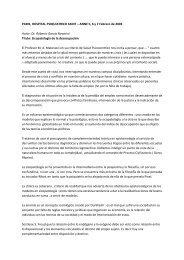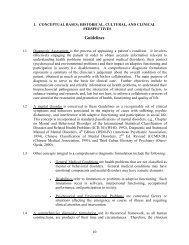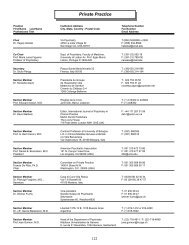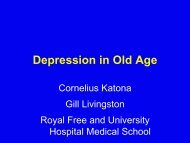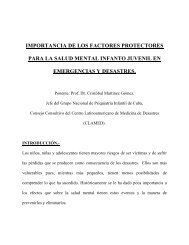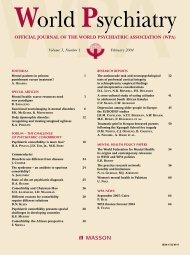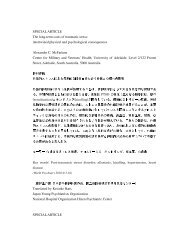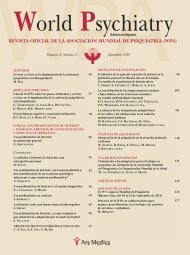ABSTRACTS - World Psychiatric Association
ABSTRACTS - World Psychiatric Association
ABSTRACTS - World Psychiatric Association
You also want an ePaper? Increase the reach of your titles
YUMPU automatically turns print PDFs into web optimized ePapers that Google loves.
suppression of the immune system in depression which is reversed<br />
with recovery.<br />
PO1.193.<br />
MODELLING G PROTEIN-MEDIATED<br />
SIGNAL TRANSDUCTION IN IMMORTALIZED<br />
HUMAN LYMPHOCYTES IN RESPONSE<br />
TO ANTIDEPRESSANT TREATMENT:<br />
POSSIBILITIES FOR DEVELOPING<br />
PATIENT-SPECIFIC PHARMACOTHERAPY<br />
S. Hodgkinson, J. Kirchheiner, W.P. Kaschka<br />
University of Ulm, Germany<br />
Perturbations in the mechanisms governing the uptake and release of<br />
neurotransmitters such as serotonin, norepinephrine and dopamine<br />
in the brain have been implicated in the aetiology of affective disorders.<br />
A number of antidepressant drugs are available that inhibit the<br />
uptake of one or more of these neurotransmitters. However, relatively<br />
little is known about the pharmacogenetic determinants of this<br />
inhibition. A better understanding of how individual patient genotypes<br />
influence the efficacy of these drugs will provide the opportunity<br />
for earlier, more targeted therapeutic interventions to be made.<br />
Immortalized human lymphocytes express a number of neurotransmitter<br />
receptors and transporters on their cell surface membrane, and<br />
thus provide a simple model system for the study of neurotransmitter<br />
uptake and release. We describe the first stages of our approach for<br />
combining mathematical modelling of the molecular processes<br />
involved in the uptake and release of serotonin, dopamine and norepinephrine<br />
by immortalized human lymphocytes, with experimental<br />
work looking at the changes in signal transduction that occur in the<br />
lymphocytes in response to a number of reuptake inhibitor antidepressants.<br />
An outline of the underlying mathematical model is provided,<br />
together with some initial findings from our experimental<br />
work. This approach provides a powerful means of testing and adapting<br />
basic mathematical models of cellular function (such as membrane<br />
transport and sequestration) using experimental data generated<br />
from the same model system.<br />
PO1.194.<br />
FETAL GROWTH RESTRICTION<br />
AND THE DEVELOPMENT OF MAJOR DEPRESSION<br />
H.-M. Vasiliadis, S.E. Gilman, S.L. Buka<br />
Department of Community Health and Sciences, University<br />
of Sherbrooke, Quebec, Canada; Departments of Epidemiology<br />
and of Society, Human Development and Health, Harvard School<br />
of Public of Health, Boston, MA, USA; Department<br />
of Community Health, Brown University, Providence, RI, USA<br />
Whether or not lower birth size is associated with a higher risk of<br />
depression in adulthood is not clear, as prior studies have reported<br />
varying results. This study aimed to test the association between fetal<br />
growth restriction and the lifetime risk of major depression and number<br />
of recurrent episodes. Study subjects (n=1101) were offspring of<br />
participants in the Providence, Rhode Island, site of the National Collaborative<br />
Perinatal Project. Cox regression was used to investigate the<br />
relation between measures of birth size and the lifetime risk of depression,<br />
and the mean number of depressive episodes was compared<br />
across categories of birth size. There was no association between low<br />
birth weight, gestational age, ponderal index, and small for gestational<br />
age and the lifetime risk of major depression, or the number of<br />
recurrent episodes. These results suggest that fetal growth restriction,<br />
as reflected by multiple measures of birth size, is not associated with<br />
the risk of a major depression or the subsequent recurrence of depressive<br />
episodes. They do not support a “fetal programming” effect in<br />
depression.<br />
PO1.195.<br />
QUALITY OF LIFE AND PERSONALITY TRAITS<br />
MODERATE THE INFLUENCE OF SEROTONIN<br />
TRANSPORTER GENETIC VARIANTS ON<br />
DEPRESSIVE SEVERITY AND TREATMENT<br />
OUTCOME IN BIPOLAR SPECTRUM DISORDERS<br />
L. Mandelli, M. Mazza, G. Martinotti, D. Tavian, E. Colombo,<br />
S. Missaglia, D. De Ronchi, R. Colombo, L. Janiri, A. Serretti<br />
Department of Psychiatry, University of Bologna; Department<br />
of Psychiatry and Institute of Biochemistry and Clinical<br />
Biochemistry, Catholic University, Gemelli Hospital, Rome;<br />
Laboratory of Human Molecular Biology and Genetics, Catholic<br />
University, Milan, Italy<br />
In the present work we aimed to test the effect of serotonin transporter<br />
gene (SLC6A4) variants on depressive outcome in combination with<br />
personal/interpersonal well-being indexes and personality traits. One<br />
hundred and thirty patients with a bipolar spectrum diagnosis were<br />
included in the sample. At intake, patients were evaluated for personality<br />
traits, depressive symptoms, quality of life (QoL) and social<br />
adjustment (SAS), and then followed for a period of 1 year under<br />
pharmacological treatment. Evaluations were repeated after 1, 3, 6 and<br />
12 months of treatment. Four SLC6A4 variants were genotyped:<br />
SERTPR, the SERTPR A/G variant (rs25531), rs25533 and STin2<br />
(VNTR in intron 2). Indicators of psychosocial adjustment (QoL and<br />
SAS), as well as personality traits, particularly Harm Avoidance (HA),<br />
significantly and strongly correlated with depressive severity at various<br />
stages of the follow-up. Controlling for confounders and covariates,<br />
SLC6A4 variants (SERTPR *S or *LG, rs25533 *T, STin2 *12 and the<br />
S-T-12 haplotype) were significantly associated with baseline depressive<br />
severity and poor outcome during treatment. A good QoL<br />
markedly favour subjects carrying risk variants, while a high HA<br />
showed an opposite effect, increasing depressive scores and reducing<br />
remission likelihood. These findings are a further confirmation of an<br />
influence of SLC6A4 on depression and its outcome. Most importantly,<br />
QoL and HA moderate genetic associations, suggesting an interactive<br />
effect between these variables and SLC6A4 variations.<br />
PO1.196.<br />
ELECTROCONVULSIVE THERAPY INCREASES<br />
SERUM GLIA CELL LINE-DERIVED NEUROTROPHIC<br />
FACTOR IN DRUG RESISTANT DEPRESSED<br />
PATIENTS<br />
Xiaobin Zhang, Zhijun Zhang, Weiwei Sha, Chunming Xie,<br />
Guangjun Xi, Honghui Zhou, Yumei Zhang<br />
Department of Neurology, Affiliated ZhongDa Hospital<br />
of Southeast University, Nanjing; Department of Psychiatry,<br />
Affiliated WuTaiShan Hospital of Yangzhou University,<br />
Yangzhou, China<br />
Electroconvulsive therapy (ECT) is effective for patients with antidepressant<br />
medication-resistant depression. However, the mechanisms<br />
of ECT’s effectiveness for treating depression are not fully understood.<br />
We investigated if ECT operates a modulation of serum glial<br />
cell line-derived neurotrophic factor (GDNF) levels in a sample of<br />
drug resistant depressed patients. There was a significant increase of<br />
serum GDNF levels in responders to ECT (before ECT: 401.7±193.2<br />
pg/ml; 5 weeks after starting ECT: 686.2±299.2 pg/ml; p=0.033),<br />
204 <strong>World</strong> Psychiatry 8:S1 - February 2009




